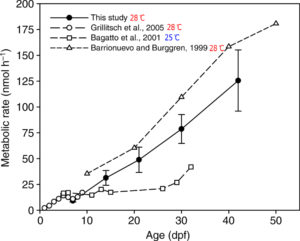The report should be written in the IMRAD format; with Introduction, Materials and Methods, Results and Discussion. Your report should contain the following sections:
Introduction:
Briefly introduce the topics metabolism, respirometry and Q10
Materials and methods:
- Briefly describe the experimental design.
- Formulas used and how to apply them;
Results:
- Present your data on oxygen consumption (nmol/ind/h) for fish egg and -larvae at the experimental temperatures.
- Present comparisons of the effects of temperature (Q10) on the oxygen uptake based on your own results.
- Alternatively, present the oxygen consumption in zebrafish eggs and -larvae at 24°C and 32°C when assuming Q10=4.5.
Discussion (make sure to discuss the following):
- How oxygen consumption is measured.
- What oxygen uptake represent.
- How and why oxygen consumption uptake change with size.
- How and why oxygen uptake is modified by temperature.
- Finally- compare your data with Figure 1 (below) and the results of Rombough and Drader 2009.
IMRAD is an acronym for Introduction, Methods, Results and Discussion. IMRAD formate is the structure of the majority of science reports and contains the following:
- Introduction – Why was this study conducted? What is the hypothesis/aim of the study?
- Methods – When, where and how was the study performed? What materials were used?
- Results – What was the results? Can it answer the research question? Was the hypothesis true? Did you meet the aim of the study?
- Discussion – What does the answer mean? And how important is the answer? Are the results coherent with previous studies? Any recommendations for future studies?
